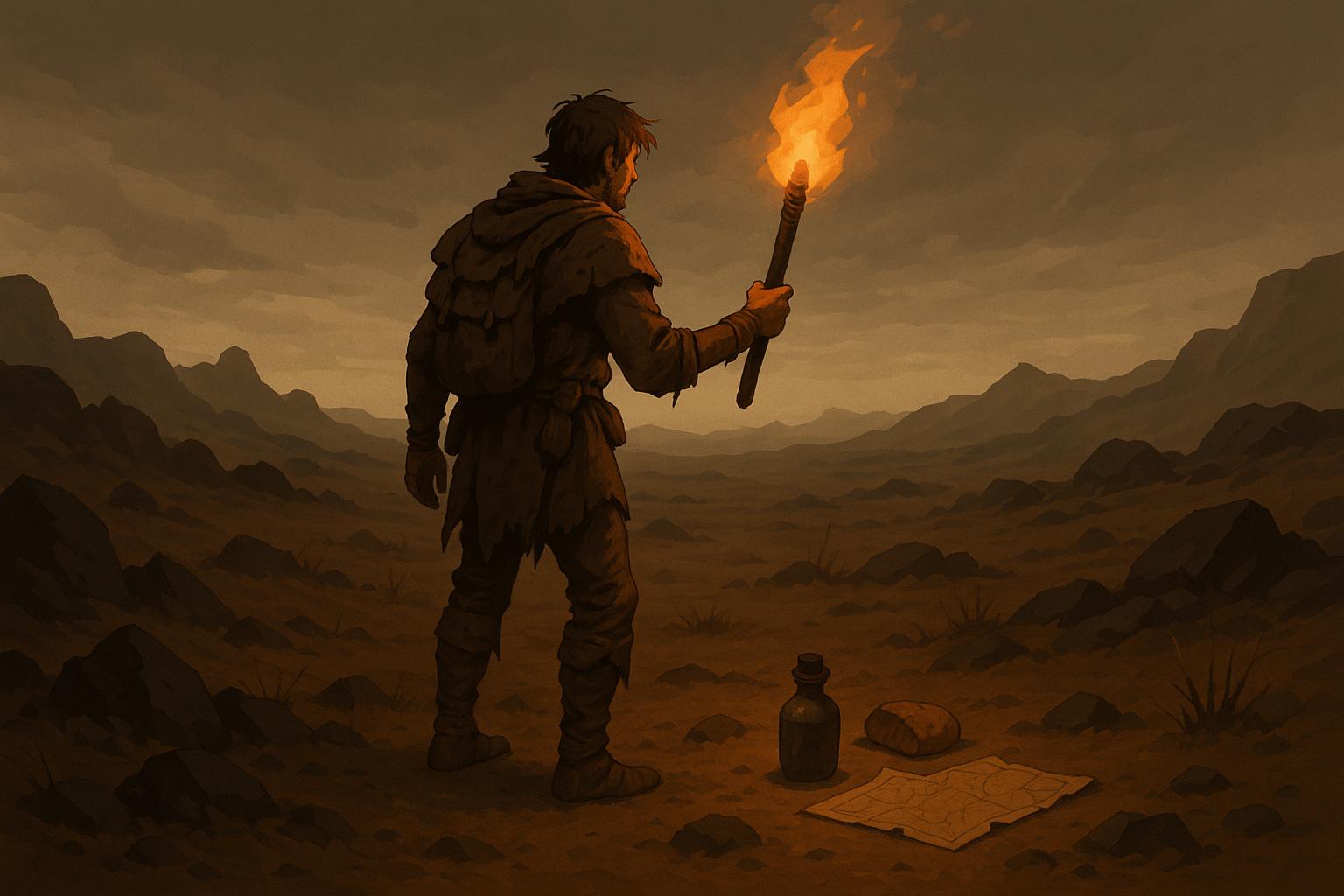Dice are the backbone of tabletop RPGs, adding unpredictability and excitement to every roll. This guide explains how dice systems work, their types, and how they shape gameplay. Here's a quick rundown:
- Why Dice Matter: They decide success or failure in actions, creating suspense and storytelling opportunities.
- Key Systems:
- d20 Systems: Single die, simple mechanics (Dungeons & Dragons).
- Dice Pools: Multiple dice for nuanced results (Shadowrun).
- Custom Dice: Unique symbols for narrative depth (Star Wars RPG).
- 2d6 Systems: Focus on partial successes (Powered by the Apocalypse).
- Modern Innovations: Systems like Blades in the Dark and Fate integrate storytelling with mechanics.
- Design Tips: Balance simplicity and depth, match mechanics to your game's theme, and test for fairness.
Whether you're a player or designer, understanding dice systems enhances gameplay and creativity. Let’s dive deeper!
Core Concepts of Dice Mechanics
Probability and Randomness
Dice are a key element in RPGs, bringing uncertainty and shaping the game through specific probability patterns. For example, the d20 in Dungeons & Dragons assigns a flat 5% chance to each possible roll, creating an even distribution. On the other hand, percentile dice (two d10s) offer 100 possible outcomes, making them perfect for detailed systems like Call of Cthulhu. Knowing these patterns allows players and Game Masters (GMs) to better anticipate outcomes and craft balanced challenges. These probabilities directly affect how success or failure plays out, influencing both the story and the overall experience.
Success and Failure
Expanding on probability, many modern RPGs go beyond simple pass/fail outcomes. They introduce layers of success and failure, including critical results, which add drama and excitement to gameplay. Different systems handle these outcomes in unique ways.
| Outcome Type | How It Works and Likelihood |
|---|---|
| Critical Success | 5% chance (e.g., rolling a natural 20 in d20 systems) |
| Standard Success | 40-60% chance (depends on target numbers and modifiers) |
| Partial Success | 20-30% chance (common in systems like PbtA) |
| Critical Failure | 5% chance (e.g., rolling a natural 1 in d20 systems) |
Skill Checks and Modifiers
Skill checks take success and failure a step further by factoring in character abilities and situational influences. These checks combine attributes, skill levels, and modifiers to create engaging challenges. Well-designed modifiers should be clear, consistent, and impactful, enhancing the game without making it overly complex.
Game designers rely on math to fine-tune these mechanics, ensuring challenges feel fair while keeping the tension alive. This balance is crucial to maintaining the thrill of uncertain outcomes while avoiding situations that feel too easy or impossibly hard.
Types of Dice Systems in Tabletop RPGs
d20 Systems
The d20 system, featured in games like Dungeons & Dragons and Pathfinder, uses a single twenty-sided die to resolve actions. Players roll the d20, add modifiers based on their character's skills and abilities, and aim to meet or exceed a target number. This simple mechanic keeps the focus on storytelling and character development while ensuring gameplay remains approachable.
Dice Pool Systems
Games like Shadowrun and World of Darkness utilize dice pool systems, where players roll multiple dice to determine outcomes. The number of dice rolled depends on a character's abilities, and successes are counted based on a target number. This method provides more nuanced results, emphasizing character skill over random chance.
| System Feature | Implementation Example | Impact on Gameplay |
|---|---|---|
| Success Counting | Each die that meets or exceeds the target counts as a success | Allows for more detailed results |
| Pool Size | Dice quantity determined by character skills | Skilled characters roll larger dice pools |
| Threshold System | Tasks may require multiple successes | Introduces varying levels of challenge |
Custom Dice Systems
Custom dice systems, like those used in the Star Wars RPG and Genesys, replace traditional numbers with unique symbols. These symbols resolve not only success or failure but also introduce narrative elements like advantages or complications, all in a single roll.
"By changing not only the dice used, but the way they're used, a game can emphasise specific aspects of whatever kind of story it's trying to tell." - Dicebreaker[4]
For instance, the Star Wars RPG uses symbols for success, failure, advantage, and disadvantage. This allows players to succeed with complications, fail with unexpected benefits, or create rich storytelling opportunities directly from the dice.
These systems have laid the groundwork for modern mechanics, refining how dice influence both gameplay and narrative depth.
4 of the Most Common TTRPG Dice Systems
sbb-itb-b8b00a5
Modern Dice Mechanics
Modern RPGs have revamped dice mechanics, blending clever design with storytelling to engage today’s players in fresh ways.
Powered by the Apocalypse (2d6 Systems)
The Powered by the Apocalypse (PbtA) system, introduced in 2010 with Apocalypse World by D. Vincent Baker and Meguey Baker, relies on rolling 2d6 to determine outcomes. The results fall into three categories: strong success (10+), partial success (7-9), and failure (6 or less). This setup drives the story by weaving complications and outcomes directly into the narrative.
| Roll Result | Outcome | What Happens |
|---|---|---|
| 10+ | Strong Success | Goal is fully achieved |
| 7-9 | Partial Success | Success comes with a catch |
| 6 or less | Failure | Consequences are introduced by the GM |
"As Baker suggests, the 2d6+modifier system is adaptable and can be tailored to suit a game's needs."
Blades in the Dark's Position and Effect

Blades in the Dark introduces two key mechanics: Position and Effect. Position reflects the level of risk involved (Controlled, Risky, Desperate), while Effect measures the potential impact of an action (Limited, Standard, Great). Together, these mechanics shape the stakes and outcomes of player decisions. This approach works especially well in heist scenarios, where weighing risks is critical to success.
Fate and Fudge Dice Systems
Fate Core, released in 2013, uses Fudge dice (dF), which have plus (+), minus (-), and blank faces. Rolls range from +4 to -4, leaning toward average results. This system shifts the focus from sheer luck to character abilities. Fate’s 'margin of success' mechanic adds another layer by emphasizing how well a character succeeds, not just if they succeed.
A standout feature of Fate is its aspect system. Players can use character traits to influence rolls, adding strategic depth. For instance, a character with the "Rivals in the Collegia Arcana" aspect might use it during a magical duel, creating opportunities for creative storytelling and tactical play.
These systems highlight how modern game design balances chance, player control, and storytelling. They provide plenty of inspiration for anyone crafting their own dice-based mechanics.
Creating Your Own Dice-Based Resolution System
Studying existing dice systems is a great starting point, but designing your own lets you shape mechanics that fit your game's specific goals.
Balancing Complexity and Simplicity
Creating dice mechanics that are easy to use while still offering depth is all about finding the right balance. A good system should:
- Use clear, consistent rules that players can pick up quickly.
- Avoid unnecessary dice rolls to keep the game moving.
- Offer meaningful choices without overwhelming players with options.
Matching Mechanics to Your Game's Theme
Your dice mechanics should reflect your game's theme. For example, Obsidian World adjusted its system to focus on consequences rather than just success or failure, which better supported its story-driven gameplay.
Think about how different dice results can set the tone for your game:
- Predictable outcomes (like rolling multiple dice) work well for more grounded, realistic stories.
- Flat probability (using a single die) introduces more unpredictability, which fits heroic or dramatic moments.
- Scaling difficulty with character progression can make gameplay feel more dynamic and rewarding.
Testing and Improving Your System
Start testing with players who are familiar with your game, then bring in new players for fresh insights. Pay attention to:
- How quickly resolutions happen - faster systems leave more room for storytelling.
- Player involvement - make sure decisions feel impactful and avoid creating strategies that are clearly the "best" every time.
- How progression scales - ensure the system evolves smoothly as characters grow.
"Game balance isn't just between different player options, but also about making sure the game as a whole is, in fact, a game, with a certain degree of failure as well as a degree of success being possible."
For more ideas, check out the TTRPG Games Directory. It’s a great resource for exploring how other games handle their dice mechanics and can spark inspiration for your own designs.
Conclusion and Resources
Future of Dice Systems in RPGs
Digital platforms like Roll20 and Fantasy Grounds are transforming tabletop RPGs by simplifying calculations and adding immersive visuals. These tools make dice mechanics smoother and more accessible for modern players. Looking ahead, AI and machine learning could introduce dynamic dice mechanics that adjust to player decisions and game contexts in real time. These advancements promise to expand creative possibilities while keeping the thrill of randomness alive.
Explore TTRPG Games Directory

If you're eager to learn more about dice systems and their role in tabletop RPGs, the TTRPG Games Directory is a great resource. It provides in-depth insights into game mechanics, helping you find games that match your style and interests.
Main Points
Dice mechanics continue to evolve, but their core purpose remains essential to game design - balancing innovation with storytelling. Here are some key highlights from this discussion:
| Aspect | Impact on Game Design |
|---|---|
| Enhanced Gameplay | Digital tools simplify and enrich the gaming experience |
| Thematic Mechanics | Systems like Blades in the Dark connect mechanics to narrative themes |
| Balanced Design | Good systems balance depth with ease of use |
"Innovative dice mechanics shape storytelling by aligning outcomes with narrative themes."
The future of dice systems lies in their ability to evolve while keeping the unpredictable nature of chance at their heart. Whether you're rolling physical dice or using digital platforms, the goal remains the same: crafting memorable, suspenseful moments that push the story forward.
For both game designers and players, understanding how these systems work can unlock exciting opportunities to create and enjoy tabletop RPGs. With traditional methods blending seamlessly with new technologies, dice mechanics are set to remain a vibrant and essential part of the gaming world.
FAQs
Here are quick answers to common questions about dice mechanics in RPGs.
Why do RPGs use dice?
Dice add an element of chance and unpredictability, influencing outcomes in combat, skill checks, and other critical moments. They strike a balance between player decision-making and randomness, ensuring every session feels dynamic and unpredictable [4][3]. For instance, Powered by the Apocalypse uses a 2d6 system to produce varying results, from partial successes to unexpected twists, which directly shape the narrative [4].
This reliance on dice has also led to the creation of many specialized dice types, each designed for specific gameplay mechanics.
What are the different types of RPG dice?
RPGs rely on polyhedral dice, each serving distinct purposes:
| Die Type | Common Uses | Notable Games |
|---|---|---|
| d4 (4-sided) | Minor damage, small bonuses | D&D (dagger damage) |
| d6 (6-sided) | Skill checks, damage | Shadowrun, GURPS |
| d8 (8-sided) | Medium weapon damage | D&D (longsword damage) |
| d10 (10-sided) | Percentile rolls | World of Darkness |
| d12 (12-sided) | Heavy weapon damage | D&D (greataxe damage) |
| d20 (20-sided) | Action resolution | D&D, Pathfinder |
"Polyhedral dice have become iconic tools in RPGs, each serving specific gameplay functions."
Different game systems use these dice in unique ways. While Dungeons & Dragons incorporates the full range of polyhedral dice, systems like Apocalypse World simplify things by focusing on specific dice types, such as 2d6, to keep the narrative front and center [1][2].
For more details on game mechanics and dice usage across various systems, check out the TTRPG Games Directory.
Knowing how dice function in RPGs deepens both player enjoyment and game design understanding.


